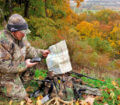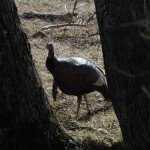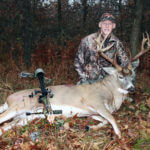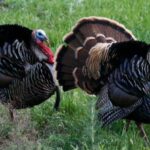Editor’s Note: How do you scout your hunting land, if that property is 8 hours and several states away from your home? Most hunters’ answers are to go in 1-week early and set-up trail cameras and deer attractant to learn what bucks are where on the property they plan to hunt. But if you don’t have the time and the money required to make several trips to the land you’ll be hunting to determine if there’s a buck big enough to hunt on this faraway property, where the buck is bedding and feeding, what trail the buck is using, what time of day or night the buck is traveling those trails, where the buck is crossing a stream, and what stand sites are available to try to take that buck or another buck on the property, why not try to find a scout near that property.
 The problem with pre-season scouting is you have to learn the land, know how not to spook the deer you’re scouting and get the most information you can about the deer on the land before the season starts. Yesterday, I mentioned how to locate a long-distance scout for you and your hunting buddies. If you find a scout who lives in the area, knows the farmer or the landowner and even may have been on the land you’re now leasing, he’ll have much-more knowledge about the deer that live on that property and in that environment than you do. If he’s a skilled deer hunter, he also knows how to scout, what deer sign to look for and how to find bedding and feeding areas, travel corridors, scrapes, rubs and other trails that deer may use. Once you talk to your scout, explain to him exactly what you want him to do.
The problem with pre-season scouting is you have to learn the land, know how not to spook the deer you’re scouting and get the most information you can about the deer on the land before the season starts. Yesterday, I mentioned how to locate a long-distance scout for you and your hunting buddies. If you find a scout who lives in the area, knows the farmer or the landowner and even may have been on the land you’re now leasing, he’ll have much-more knowledge about the deer that live on that property and in that environment than you do. If he’s a skilled deer hunter, he also knows how to scout, what deer sign to look for and how to find bedding and feeding areas, travel corridors, scrapes, rubs and other trails that deer may use. Once you talk to your scout, explain to him exactly what you want him to do.
Here’s a list of tasks you may want to tell your scout to do before you arrive.
* Locate where the big bucks are feeding, bedding, traveling and meeting their does or where they have set-up scrape lines.
* Look for tree stand sites for bowhunting, shotgun hunting and/or rifle hunting, depending on the type of hunting you’ll be doing.
* Put out a deer attractant near the tree stand site where you’ll be able to see the deer coming and know where the deer should appear within gun range, depending on the type of weapon with which you plan to hunt.
 * Set-up a trail camera near each of the attractant sites the scout selects. Number each of the sites. Then when you refer to a particular site by a certain number, you and the scout will know the locations to which you’re referring.
* Set-up a trail camera near each of the attractant sites the scout selects. Number each of the sites. Then when you refer to a particular site by a certain number, you and the scout will know the locations to which you’re referring.
* Look for the easiest and the quickest way to get to and from that site without disturbing the bucks that will be coming there.
* Set-up several-different stand sites, so regardless of which way the wind’s blowing on the day you hunt, you’ll always have a stand site where you can hunt.
* Send two aerial photos and/or topo maps of the property to your scout. Then he can mark the stand sites where he’s set-up the cameras and the deer attractant on both maps and send you one copy, while he keeps the second. This way, the scout can explain over the phone what line of travel to take to reach each stand site, and you can mark the path that you need to walk on your map.
* Discuss how often he’d be available to freshen-up the atractant you’ve shipped to him at your potential stand sites, and pull the flashcards in the trail cameras to send them to you. Ideally, 6-to 8-weeks out to hunting season, the scout can pull the flash cards from the trail cameras, send them to you and insert new flash cards. To accomplish this task, you’ll need to provide your long-distance scout with two cards for each camera, so each time he pulls a card from the trail camera and sends it to you, he’ll have a new card to put into the camera. Once you receive the cards with the images of the animals coming to the attractant and download the images to your computer, you immediately can delete the pictures off the card and send the cards back to the scout.
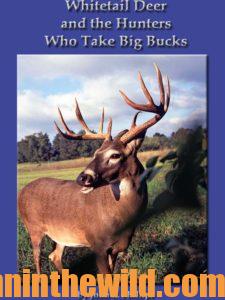
 To learn more about hunting deer, go to John E. Phillips’s book, “Whitetail Deer and the Hunters Who Take Big Bucks” at https://www.amazon.com/Whitetail-Deer-Hunters-Take-Bucks-ebook/dp/B01KU0O1KY, available in Kindle and print versions.
To learn more about hunting deer, go to John E. Phillips’s book, “Whitetail Deer and the Hunters Who Take Big Bucks” at https://www.amazon.com/Whitetail-Deer-Hunters-Take-Bucks-ebook/dp/B01KU0O1KY, available in Kindle and print versions.
To receive your free book on “How to Make Venison Jerky,” go to https://www.emailmeform.com/builder/form/Ece3UZVcOo52cKPJcL.
Tomorrow: How to Process Information about Deer and Their Habitats in Other States and Use Cameras, Deer Attractants and Maps


